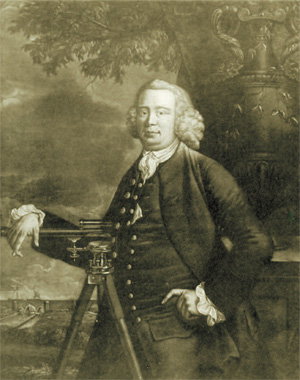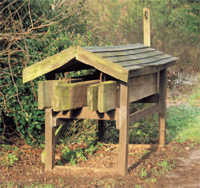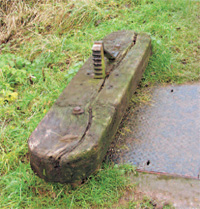Beginnings
James Brindley, the engineer of the Trent
and Mersey Canal, was a giant of the
canal age. He had a vision of connecting
the four main rivers of England (Trent,
Mersey, Severn and Thames) in an
ambitious scheme known as the Grand
Cross. This canal was part of that scheme
and was also known as the Grand Trunk
canal.

James Brindley, the great canal engineer. The first of his
towering achievements to fire the imagination of the age was
his aqueduct near Manchester, which carried a canal ‘as high
as the tree tops’ over the River Irwell.
Image reproduced courtesy of the Institution of Civil Engineers
Josiah Wedgwood, the pottery designer and
manufacturer based in Stoke-on-Trent, saw how a canal
could be a vital route for the transport of his wares.
Canals offered a smooth ride for his pottery, which could
otherwise be easily broken. He was present at the
momentous meeting at Wolseley Bridge, just outside
Rugeley, where the canal was planned in 1765. It was
opened fully in 1777.
The canal helped to raise the profile of Rugeley and
greatly benefited the trades and industries of the town.
It had cost approximately £300,000 to build (equivalent to over 27 million
pounds today) but was nevertheless a good investment, as carriage costs
were reduced by over two thirds. It cost nine shillings (45p) to transport a ton
by road and two shillings and sixpence (12.5p) by canal.
The murder of Christina Collins
On 15 June, 1839, Christina Collins began her
journey as a passenger on a freight-carrying
narrowboat from Liverpool. Her intended
destination was London, where her husband had
gone to look for work. She never got there. Her
body was found in the canal at Brindley Bank near
Rugeley aqueduct, about a mile from here. Two of
the crew of boatmen with whom she had shared
her journey were later convicted of her murder.
The story was used by the author of the Inspector
Morse novels, Colin Dexter, in ‘The Wench is
Dead’.

These steps, known locally as the Bloody Steps,
are at Brindley Bank, just outside Rugeley. It was
here that Christina Collins’ body was carried after
being found in the canal. Some said that her
blood had dripped on the steps and stained them,
giving rise to the local legend: the ‘Bloody Steps’.

Nearly 10,000 people attended the
hanging of James Owen and George
Thomas in Stafford for the murder of
Christina Collins. This broadsheet
shows the portable gallows that was
wheeled out of the gaol gatehouse
into Gaol Road to enable the public
to view the hanging.
|
From commerce to leisure
The development of the railway network in the mid 1800s brought a cheaper and quicker method of transporting goods and presented canals with a serious threat. In 1846 the Trent and Mersey Canal Company merged with the North Staffordshire Railway Company, but by the 1860s the canal had lost much of its business. The next hundred years saw the canal struggling to recover and a steady decline in commercial traffic. Today, under the control of British Waterways, leisure use has grown and traffic is mostly recreational.

A boatman and his family on the Trent and Mersey Canal at Rugeley, c1890–1900. Horses were used to draw the narrowboats, and could transport up to one hundred times more weight on water than on land.
Image courtesy of Staffordshire Arts & Museum Service
Spot the differences
These two photographs,
taken one hundred years
apart, show the same spot
on the canal, at Trent Lane
about four miles from Great
Haywood. The lock-keeper’s
house, seen in the earlier
photograph, still stands.
The narrowboats seen on
the canal now are more
likely to be pleasure boats
than the industrial
transporters of a hundred
years ago.
1908

Image courtesy of Staffordshire
Arts & Museum Service
2008


The junction of the Trent and Mersey Canal and the Staffordshire and
Worcestershire Canal at Great Haywood. Construction of both canals was
granted by Act of Parliament on the same day.

|















